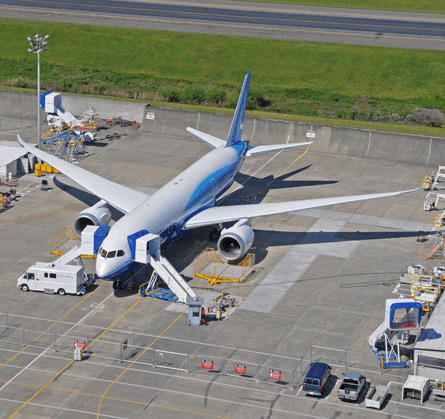Boeing has identified the design of the structural fix needed to get the 787 into flight test. However, the airframer has not yet determined what impact the problem will have on the programme schedule or guidance on what may be a hefty financial toll after two years of delays.
The latest slip has been caused by a side-of-body structural issue discovered during static testing in May, which requires the reinforcement on the wing join. Boeing chief executive James McNerney says that the company has duplicated the "conditions we discovered during static testing" in analytical models, adding that "we have identified a technical solution chosen from a number of options".
 |
|---|
© BoeingA side-of-body structural issue was discovered during static testing of the 787 |
McNerney says the problem inside the wing stringer at the side-of-body where the wing and centre wing box meet is "a local issue which can be addressed with a local fix" and does not have larger design implications on the wing.
His sentiment is echoed by a senior programme source: "There is good news and bad news. The good news is we know what to fix, and how to fix it." The bad news, the source adds, is that it is very difficult to gain access to.
As a result of the installation challenges ahead the timeline for first flight of the 787 remains unclear, although Boeing promises to make the revised schedule available before the end of September.
Under the previously revised schedule, the first 787 was due to fly by the end of June, with first delivery in February 2010 to Japan's All Nippon Airways.
While the fix is being developed and a final revised schedule finalised for airlines, sources at both Boeing and partner suppliers indicate that the existing production plan has slid by roughly one to three months for the delivery of components for aircraft 10 to Everett, even as suppliers continue to prepare parts for shipment.
Boeing has assembled six flight-test aircraft, two ground-test aircraft and one production 787. Last week it rolled out the fifth 787, which is the first to be powered by General Electric GEnx engines, in a special white and blue colour scheme. Boeing says its two GEnx engines have been temporarily removed and returned to GE Aviation to undergo "planned minor improvements".
Boeing has nine 787s at Everett that have gone through, or continue to undergo, final assembly operations, and delivery of structural sections for the 10th has begun.
The slip, the sources say, allows Boeing to finalise and test the fix, and limit the number of aircraft in final assembly required to undergo modification in Everett.
The final fix, they add, widely believed to be titanium, is extremely tight and difficult to reach as the installation area of repair will provide very little room to install the fasteners to secure the reinforcement. Installation could begin as early as the middle of August, with installation times around one month for each already assembled aircraft, sources estimate.
The first aircraft, "ZA001", is expected to leave the flight line for painting where it will undergo modification, while ZA002 will remain on the Everett flight line and the side of body will be covered with a tent to protect the aircraft.
Even with the remedial fix in the works, a key discussion centres on the future of 787 production and when the permanent fix is designed into the wing-to-body join.
Sources say a revision of the upper part of the wing-to-body join is almost certainly necessary to create a permanent long-term solution and eliminate the time-consuming installation of the remedial fix.
Source: Flight International























